Warning: lengthy post ahead
Last October 2015, I attempted my most ambitious travel yet: 21 days in Japan. I say it's ambitious because of the high cost of living in the country, my intended length of stay, and the spontaneity of the plan. Japan was never in my short-term travel list but circumstances seemed to favor advancing it and so I took a leap and thankfully survived.
Below is an overview of how I spent my 21 days in the country.
 |
| Google Maps screenshot of my travel itinerary |
Itinerary
Day 1-3: Arrival at Kansai International Airport (KIX), Explore Osaka
Although I did my research on how to get out from the airport to the city-center, I felt completely lost in front of the super-sized Train Network Map and beeping Ticket Vending Machines. There was an overwhelming surplus of Japanese characters and I just stood in confusion with my 20kg backpacks until I gathered enough wit to ask at an open counter. I eventually made my way to my hostel that night and figured out the train system in the succeeding days.
 |
| Japanese characters plastered all in front of a local restaurant |
Osaka is known as the Food Capital of Japan and locals are said to go broke from eating out so much. For a first-time visitor, the Japanese menu and non-Japanese speaking servers may seem intimidating. Fortunately, in some restaurants, pictures of food are displayed outside making it possible to just point at the food order (turo-turo style).
 |
| Food replicas displayed on a restaurant window to both entice and guide customers |
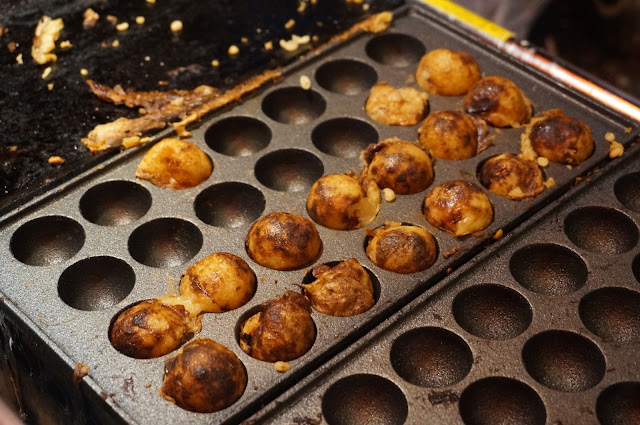 |
| While walking around, I stumbled upon a takoyaki stand and was fortunate enough to get the last set of balls for the night |
Aside from a bit of eating, I also did some touring. I purchased a day pass for 800 yen which allowed me unlimited rides on the subway.
 |
| With my Map and Day Pass, I am ready to explore Osaka |
 |
| Osaka Castle |
 |
| Namba shopping district |
 |
| The famous Glico man (Glico is the company behind the Pocky brand) |
 |
| Dotonbori entertainment district |
Day 4-12: Living Local in Kyoto
To save on accommodations, I decided to stay put in Kyoto for a few days. This enabled me to soak in the city not as a visitor but as a resident and it has been one of the most significant experiences of my life.
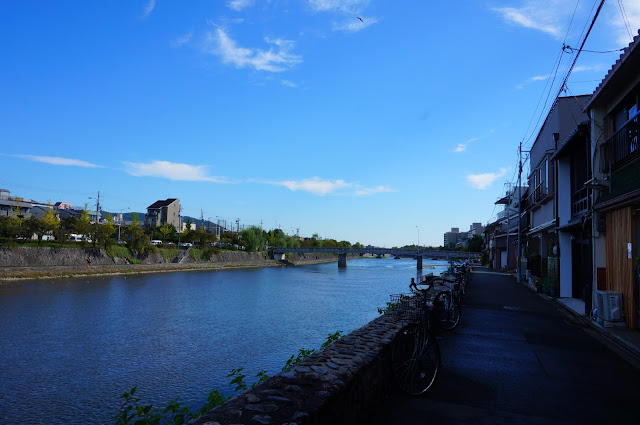 |
| The majestic Kamogawa River not given justice by this picture |
Upon getting off at Hankyu Kawaramachi station, I was welcomed by a silently gushing river on a warm mid-afternoon. I instantly imagined myself lying down along the wide riverbank, bathing in sunlight, and taking in the sounds of the river and the city. Although I wasn't able to do exactly this, I was still able to enjoy the many big and small rivers of Kyoto as well as its enjoyable cold Autumn weather.
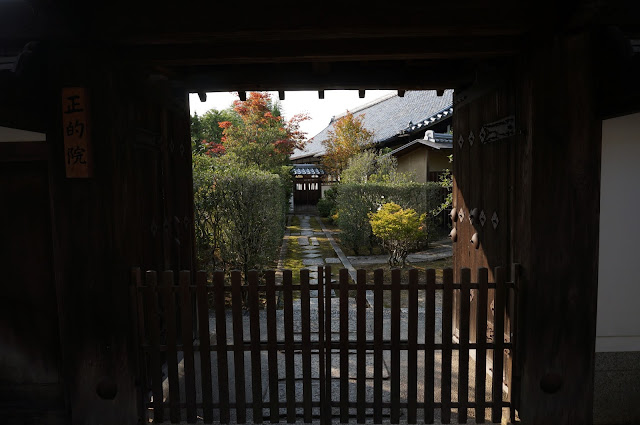 |
| Behind these gates are moss-covered pathways and intricate gardens, so says the guide book |
Kyoto is home to over 1,600 temples. However, entrance to the big and popular ones is not free so I contented myself with just taking peaks or strolling around the exterior gardens. I paid to get in only one of them (Sanjusangen-do) but I'm sure the other bigger temples would be worth the fee especially if I could spend a few hours going around them.
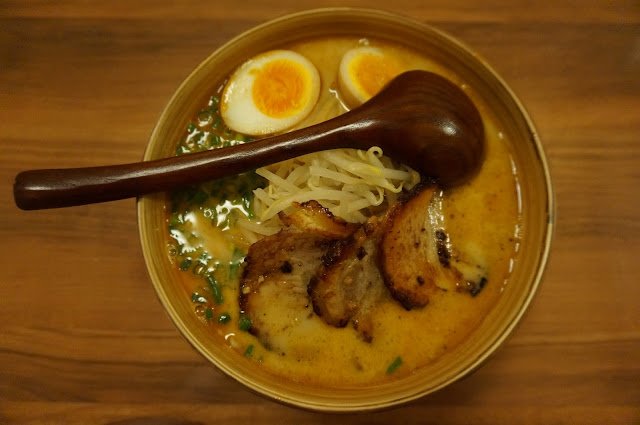 |
| Ramen Sen No Kaze: the best chashu that I had. The ramen itself was also noteworthy |
Daily objectives in Kyoto included looking for a good and cheap place to eat. There was a time when we had a super late lunch at 4pm and we decided to eat ramen. I got intoxicated by both the flavor and by having something in my stomach that I was literally just smiling to myself. We were also so full afterwards that we just went and took a nap (siesta) by the riverbanks.
 |
| Favorite Japanese food in Japan: Takoyaki |
On my last night in Kyoto, we bought Takoyaki and beer and walked to the river again for a last (for now) session of life talks, travel stories, and personal sentiments. It was the end of the beginning of my love story with Kyoto.
Day 13: Shinkansen #1, View of Mt. Fuji from Gotemba
I took an early morning Shinkansen (bullet train) to Nagoya to meet up with Filipino friends. Afterwards, we took another Shinkansen together to Gotemba. The glorious Mt. Fuji was at the left-hand side of the train car throughout the 30-minute ride.
 |
| Mt. Fuji behind a foreground of greens and yellows. Credits to Marloweee for the Instragram shot |
Day 14: Exploring Tokyo by Bike
The next morning, we woke up in Tokyo and rented ourselves a pair of folding bikes. We cycled the whole day from Asakusa to Tsukiji to Ginza to Ropponggi and to Shibuya. It was fun and liberating but it was also exhausting and inconvenient. We didn't want to cycle back so we folded the bikes and dragged them onto the trains.
 |
| From Tsukiji, we crossed the river, cycled under the bridge, and dragged our bikes back up the road. Taken by Marloweee |
 |
| One of the shopping streets in Ginza. Spot the Uniqlo store. Taken by Marloweee |
Day 15: Flowers of Hitachi Seaside Park
After successfully pulling ourselves out of bed following an exhaustive yesterday, we were just in time for the 11:30am Shinkansen to Katsuta Station. We spent the whole day walking around Hitachi Seaside Park which is home to a thousand varieties of plants and to billions of blooming flowers, alongside cycling trails and an amusement park.
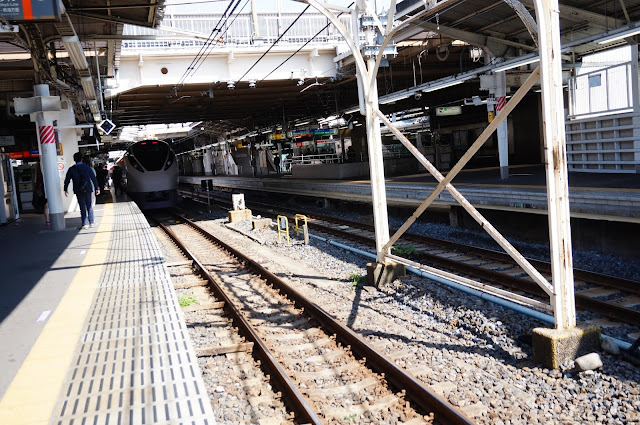 |
| A typical view of train tracks, bullet trains, and people running towards (along) them. |
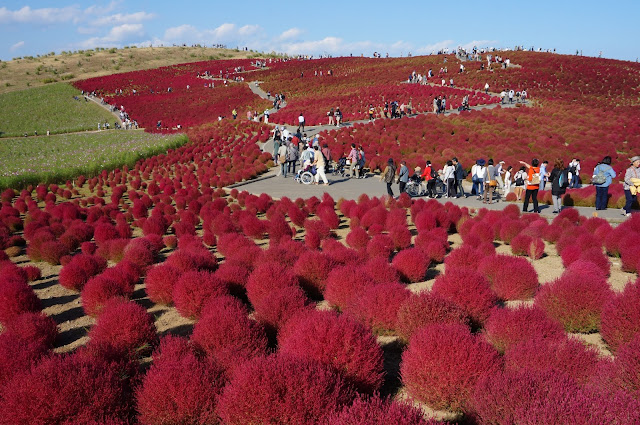 |
| The whole while, the image of the Lorax and his red trees kept popping in my head |
 |
| Have you ever seen a red rose in FULL bloom? |
 |
| A towering Ferris Wheel in the midst of bushes, gardens, and greens |
At closing time, we headed straight to the park's bus station and was immediately met by a long line of people waiting for the same bus. Because we were feeling a bit adventurous, we decided to walk 4kms to the nearest train station instead in order to avoid the line and maybe get a preview of the ocean. This led to a very adventurous night indeed. More on this in a separate post.
 |
| We walked more than 4kms along a deserted pathway littered with dead leaves and large spiders |
Day 16: Exploring Tokyo by Foot and by Rail
We were supposed to leave for Nikko this day but felt that we haven't explored enough of Tokyo so we decided to go through as much of the metro city as we can while hunting for coffee shops and bike shops.
 |
| Owner Eiichi Kunitomo delicately crafts each cup and shot himself |
Our first stop was Omotesando Koffee, a small specialty coffee shop (more of a pop-up store actually) hidden in the Harajuku district. It is manned by a single barista pulling espressos inside a 3x3m cube with a small garden as a sitting area for four people.
 |
| Espresso macchiato |
Afterwards, we walked from Harajuku to Shibuya, stopping at hipster shops, looking out for specialty coffee shops, and checking out bicycles along the way. The Omotesando area was really nice with all its side-streets, local boutique stores, and terrain.
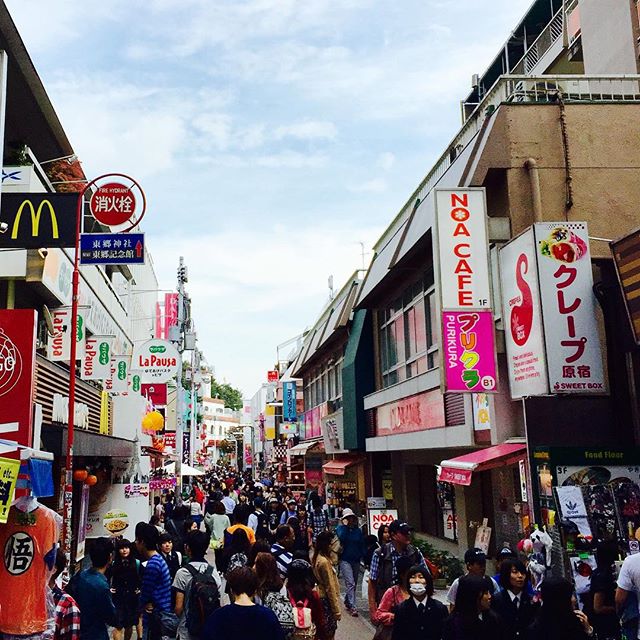 |
| A carpet of people along Takeshita Dori on the lookout for cosplayers and fancy finds. Taken by Marloweee |
Our last stop for the day was Akihabara which is the closest to the Tokyo that foreigners imagine -- Maid cafes, Anime shops, the latest gadgets, electronic billboards, and other crazy stuff -- except toned down a little bit.
 |
| Overwhelmed by all the lights, sounds, and images -- and this was just inside the arcade. Taken by Marloweee. |
Day 17: Yudanaka and its Monkeys
At lunch time the following day, we were on a bullet train again, this time headed for the mountains -- to the Nagano prefecture. We passed by numerous orchards and shrieked in awe over the humungous apples popping out against a green background of leaves. Upon arrival at Yudanaka Station, we were met by an elderly man who was part of a group that practices their English by greeting tourists. He pointed us towards our ryokan (traditional Japanese Inn) where we checked in and quickly ran out again to catch the last opening hours of the Snow Monkey Park.
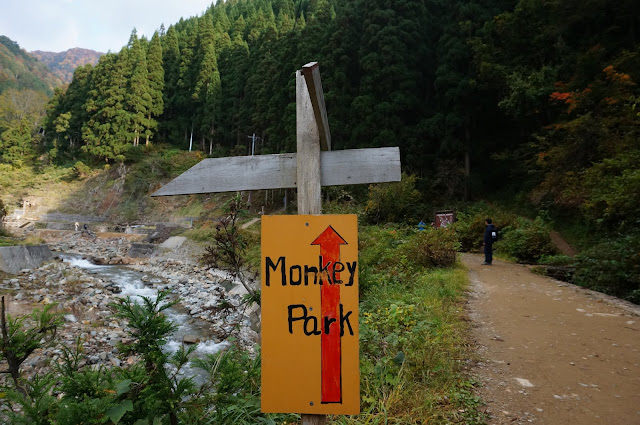 |
| The Jigokudani Yaen-koen Park is most popularly visited for the macaque monkeys that inhabit the area |
 |
| We walked 2kms for around 30 mins along the Yumichi Natural Trail to get to where the monkeys hang-out |
 |
| For some reason, the monkeys have grown accustomed to humans within their habitat whom they pay absolutely no attention to |
 |
| The monkeys can be seen bathing in the onsen (hot spring) during winter which is how they have been known as snow monkeys |
 |
| Aside from the snow monkeys, Yudanaka is also known as a hot spring resort destination and is lined with traditional ryokans and small hotels |
Day 18: An Old Guesthouse and a Peaceful Mountain Lookout in Suzaka
The next morning, under a strict schedule for waking up, dipping in the onsen, packing our bags, saying goodbye to our homey host, and walking to the station, we hopped on the train again to Suzaka, a town settled between apple farms and mountainous forests.
 |
| Unpopular to tourists, Suzaka City is populated by store houses owing to its history of having a thriving spinning business |
The city had a small town feel where everyone seems to know everyone. It wasn't initially in our list but a good friend strongly recommended it and we obliged. We were only targeting for Guesthouse Kura, a 100-year old Japanese house that has been converted into a guesthouse, but was similarly impressed by the creative use of the store houses, the peacefulness of the city, and the electric cars that darted every now and then.
 |
| Garyu Park is a good destination for both residents and visitors for mountain strolling, fish-feeding, and boating, as well as cherry blossom-viewing in the summer |
 |
| After a short uphill trail, we found this look-out area and just stayed to absorb the surrounding nature and to observe the bustle below |
Day 19: Ninja tricks and fall leaves in Togakushi
Early the next day, we ran after the hourly Nagano Dentetsu Train to Nagano under another strict schedule. We were bound for Togakushi in the morning and for Nagoya in the evening, and with limited train schedules and long travel times, we kept running after one departure time to another.
 |
| Our first stop in Togakushi is the Ninja House where we skimmed through a ninja obstacle course and figured our way out of a Ninja Trick House |
After dropping our bags at a locker in Nagano Station and picking up breakfast from a convenience store, we stood in line for the bus headed to Togakushi. It was an hour ride up the mountain passing through dense forests that transform into skiing routes come winter.
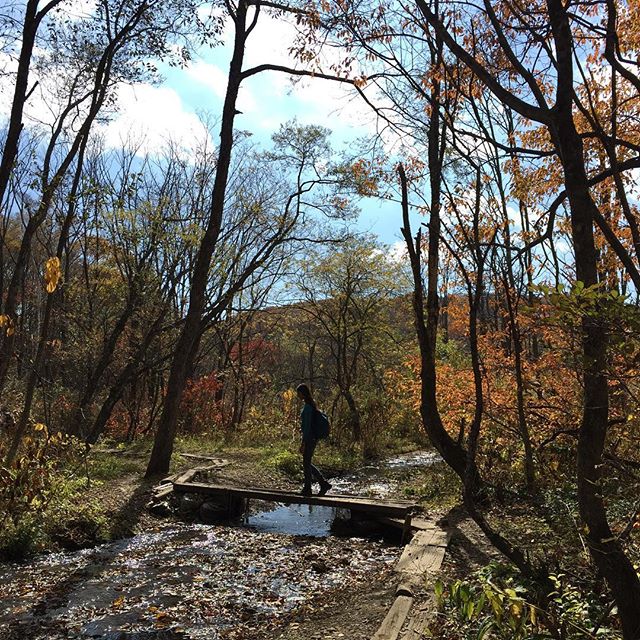 |
| Crossing a creek along the trail from Chusha Shrine to Kagami Ike. Taken by Marlowee |
 |
| The colors of fall |
After a quick hike up Chusha Shrine amidst towering ancient trees and a shower of fall leaves, we found our way to Kagami Ike (Kagami Lake) and marveled at the gradients of autumn over a backdrop of clear blue skies and shadowy mountains.
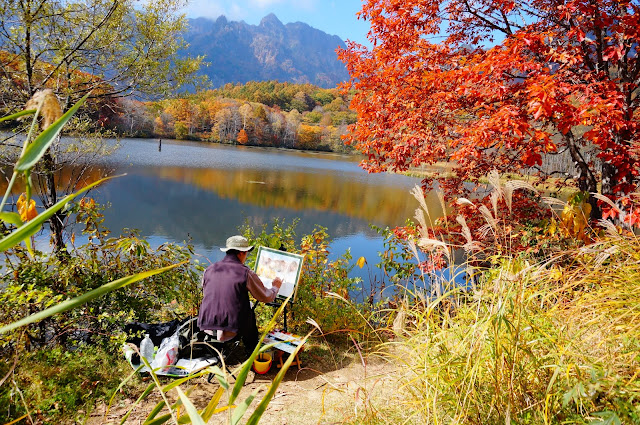 |
| One of the painters in the immediate area attempting to replicate the colors of nature |
Walking a bit away from the packed noodle restaurants, we chanced upon an empty restaurant and became its sole customers. I watched as the cook made the noodles from scratch, cut it by hand in even thickness, and cooked it by dipping several times into the hot broth. Aside from the especially-made food, we also enjoyed a quick chat with the cook about upcoming storms in the Philippines and his changing occupation based on the season, i.e. a lift operator in the winter and a soba cook in other seasons.
 |
| Hot Togakushi Soba freshly made and served with cold soft pumpkin |
Arriving back at Nagano Station aboard the same Togakushi line bus, we savored the few minutes we could stop and walk slowly before running again to pick up our bags from the rental locker and to catch the Limited Express Shinano line to Nagoya.
Day 20: Bicycles and walks in Nagoya
Following a hectic and tiring yesterday, we decided to take a slow day. After getting a meaty lunch alongside locals, we went to Sakura Honmachi Station where we hunted for bicycle parts and for random streets. With only my mental compass as guide, I walked the whole afternoon across bridges and along empty streets until I saw the sun set. And then I walked all the way back, losing my bearings in between but always finding my way.
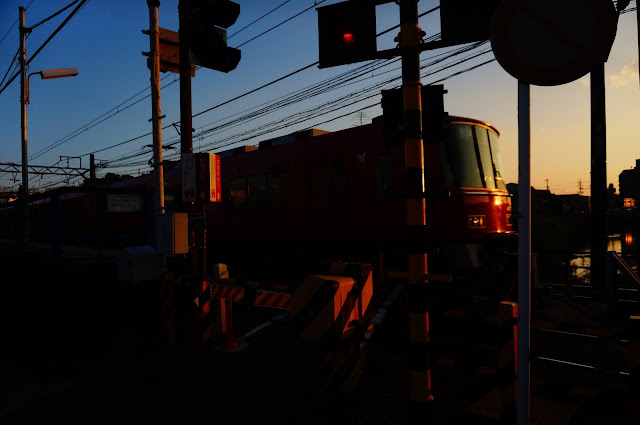 |
| A random picture of a random train crossing a random road highlighted by a random sunset |
 |
| A Disney wonderland for some. Taken by Marloweee |
Day 21: Toyota Plant Tour, Departure from Chubu Centrair International Airport (NGO)
On the morning of our departure, we managed to squeeze in a scheduled tour of the Toyota Plant. It was an hour and a half travel where we again secured our bags at a train station locker before running after the 10:30 am call time at Toyota Kaikan Museum. It was an interesting and interactive tour and I wish we were given more time and freedom to explore. Pictures weren't allowed so I'll leave you with this link on
how to sign up for the guided plant tour.
At 5:30 pm, we were awaiting the shuttle bus that will take us directly to Chubu Airport. I took my last glimpse and feel of the once daunting country that have become another home away from home before blending in with the familiar hustle and bustle of other Filipinos also headed back to Manila.
Trip total including airfare and taxes for 21 days: ~Php 60,000








































